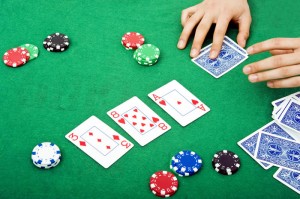 So you decided to make a move with your hole cards and made your opening bets based on what was their perceived strength. What do you do now in the post flop? This is the major turning point in the game and where decision making and betting become increasingly important and difficult. Your decision to continue with a hand or not should be based on a few basic but important factors.
So you decided to make a move with your hole cards and made your opening bets based on what was their perceived strength. What do you do now in the post flop? This is the major turning point in the game and where decision making and betting become increasingly important and difficult. Your decision to continue with a hand or not should be based on a few basic but important factors.
How many players are still playing the hand? Simple logic dictates that the more players still in the hand the less likely you are holding the winning hand. Who are these players still playing? Did they raise the blinds pre-flop or did they limp in? When they called the blinds or the raises how much time did they consider the action? Typically players that take longer to think about calling a bet are holding connectors, low pairs, bad kickers, or low ranking suited cards. Are they the chip leader or the short stack? Short stacks are commonly turtling for an opportunity to double or triple up while chip leaders are more loose. What are the other players’ play style? Do they bluff? Are they playing aggressively or passively? Passive players don’t play hands that they can’t win and tend not to bluff while the aggressive players tend to do the exact opposite.
When playing live poker at a table and not online there are psychological and social factors to consider. How did they verbally or non-verbally respond to the flop? Watch and mentally record your opponents’ initial reactions even before their turn to act. Be attentive to tells like player posture, positioning in the table, face touching, hand tremors, erratic eye movements, excessive chattiness or even abject silence. It’s all part of reading your opponent. The smallest things can give away their entire hand and you may discover if you pay attention that good players have some of the most obvious tells.
It’s difficult to explain the inner working of these tells and definitively define their meaning. Numerous exhaustive texts have been written on the subject over the years that go into detail but what is important to know is that there are no definitive catch all explanations to what any behavior means. You have to watch them and mentally record from one hand to the next what they do and how they play. But never let on that you are doing so as the best players can feed you misinformation in the form of faulty tells or change play style from aggressive to passive or vice versa.
